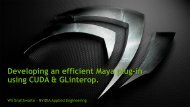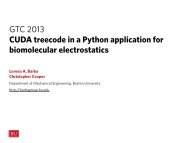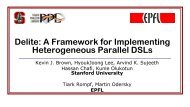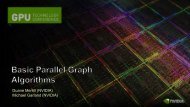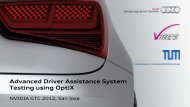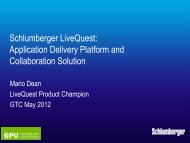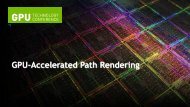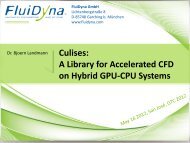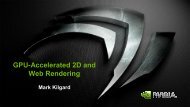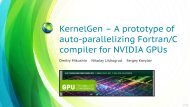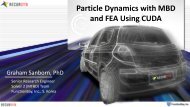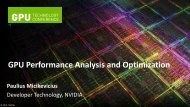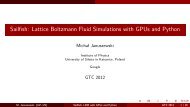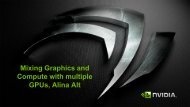GTC 2012 Program Guide - GPU Technology Conference
GTC 2012 Program Guide - GPU Technology Conference
GTC 2012 Program Guide - GPU Technology Conference
You also want an ePaper? Increase the reach of your titles
YUMPU automatically turns print PDFs into web optimized ePapers that Google loves.
TUESDAY<br />
TUESDAY, MAY 15, 09:00 (50 MINUTES)<br />
ROOM C<br />
S0419A Optimizing Application Performance with CUDA<br />
Profiling Tools<br />
NVIDIA provides two powerful profiling tools that you can use to<br />
maximize your application’s performance. The NVIDIA Visual Profiler<br />
helps you understand your application’s behavior with a detailed<br />
timeline and data from <strong>GPU</strong> performance counters. The Visual<br />
Profiler also provides an automatic, data-driven analysis engine that<br />
provides suggestions on potential optimization strategies for your<br />
application. Nvprof is a command-line profiler that provides<br />
gprof-like functionality for the <strong>GPU</strong>. Nvprof provides summary<br />
information about where your application is spending the most time,<br />
so that you can focus your optimization efforts. This session will<br />
provide a step-by-step walk through of both of these profiling tools,<br />
showing how you can use these tools to identify optimization<br />
opportunities at the application, kernel, and source-line levels.<br />
This session will repeat Wednesday at 14:00 (S0419B).<br />
Speaker(s): David Goodwin (Software Engineer, NVIDIA)<br />
Topic(s): Development Tools & Libraries (Beginner)<br />
TUESDAY, MAY 15, 09:00 (25 MINUTES)<br />
ROOM J2<br />
S0527 <strong>GPU</strong>s and the Next-Generation Aerial Surveillance<br />
Graphics processors are already used for computationally<br />
intensive video tasks in many ISR (Intelligence, Surveillance,<br />
Reconnaissance) applications; <strong>GPU</strong>-based system for video<br />
enhancement and analytics outperforms a similarly priced<br />
CPU-based system 5-to-1 at HD resolutions. Our initial tests on 64<br />
megapixel Wide Area Aerial Surveillance (WAAS) data show at least<br />
10x speedup with tasks such as super-resolution or moving target<br />
indication. In this talk, we’ll discuss unique design and<br />
implementation challenges of real-time processing of very large<br />
video data sets. We will demonstrate our existing <strong>GPU</strong>-based<br />
software, IKENA ISR, and discuss its video-processing pipeline and<br />
innovative processing solutions that are promising to dramatically<br />
expand capabilities of emerging aerial surveillance platforms.<br />
Speaker(s): Nikola Bozinovic (CTO, MotionDSP)<br />
Topic(s): General Interest (Beginner)<br />
TUESDAY, MAY 15, 09:00 (25 MINUTES)<br />
ROOM A1<br />
S0607 High Performance 3D Perception<br />
The path to general purpose graphics programming was driven by<br />
computer graphics: the process of rendering 3d models into 2d<br />
viewpoints. With the advent of flexible programming of GP<strong>GPU</strong><br />
processing, this process can be reversed. 3D perception is the<br />
problem of inferring structure and motion of the physical world<br />
from 2d and 3d measurements. In this talk, we will demonstrate<br />
the role GP<strong>GPU</strong> plays in a diverse set of applications in high speed<br />
3d perception and discuss optimization of these techniques for the<br />
GP<strong>GPU</strong>. We also demonstrate several capabilities of future<br />
systems which are enabled by GP<strong>GPU</strong> technologies.<br />
Speaker(s): Chris Slaughter (President, University of Texas Perception,<br />
Lynx Labs)<br />
Topic(s): Computer Vision (Beginner)<br />
TUESDAY, MAY 15, 09:30 (25 MINUTES)<br />
ROOM J2<br />
S0040 Introducing CUDA in KBE Applications for Digital<br />
Vehicle Development <strong>Program</strong>s<br />
Get the latest development in Next Generation Knowledge Based<br />
Engineering (KBE) software which provides real results over the<br />
traditional design approach. Today there exist numerous KBE<br />
applications in the field of vehicle ergonomics, suspension, NVH,<br />
safety, regulations etc which deal with huge number of iterations<br />
and mathematical algorithm. With <strong>GPU</strong> computing and CUDA the<br />
KBE kernel is restructured to incorporate parallel programming<br />
model which helps the applications run faster and achieving time<br />
reduction from hours to seconds. KBE geometry kernel also gets<br />
benefited by enabling CUDA in topology based operations which<br />
take lot of time when performed on CPU.<br />
Speaker(s): Avijit Santra (Project Manager, Knowledge Based<br />
Engineering, Tata Motors Limited)<br />
Topic(s): General Interest (Intermediate)<br />
TUESDAY, MAY 15, 09:30 (25 MINUTES)<br />
ROOM K<br />
S0083 Swift: A <strong>GPU</strong>-based Smith-Waterman Sequence<br />
Alignment <strong>Program</strong><br />
This session describes Swift, a <strong>GPU</strong>-based Smith-Waterman<br />
implementation for aligning short DNA sequences to large<br />
genomes. Swift has been designed to reduce computation time<br />
and lower hardware cost. Also, unlike other leading <strong>GPU</strong>-based<br />
Smith-Waterman sequence alignment programs like CUDASW++<br />
and SWCUDA which focus on protein sequence alignment, Swift<br />
has been developed for DNA sequence alignment. Swift performs<br />
200x faster than CUDASW++ using a test data set containing 1000<br />
reads (100 bases each) and 1000 references (1000 bases each),<br />
and it performs 11x faster than the CPU-based implementation of<br />
Smith-Waterman using 24 million reads (100 bases each) and<br />
human chromosome 1.<br />
Speaker(s): Pankaj Gupta (Bioinformatics Application Developer, St<br />
Jude Children’s Research Hospital)<br />
Topic(s): Bioinformatics (Beginner)<br />
TUESDAY, MAY 15, 09:30 (25 MINUTES)<br />
ROOM A7<br />
S0258 Sailfish: Lattice Boltzmann Fluid Simulations with<br />
<strong>GPU</strong>s and Python<br />
Learn how Run-Time Code Generation (RTCG) techniques allowed<br />
for fast development of a lattice Boltzmann (LB) fluid dynamics<br />
solver called Sailfish. Sailfish is completely open source, supports<br />
a wide variety of LB models (single and multiple relaxation times,<br />
the entropic model; single and binary fluids) and can take<br />
advantage of multiple <strong>GPU</strong>s. Even though the project is written<br />
predominantly in Python, no performance compromises are made.<br />
This talk will introduce the basic design principles of Sailfish and<br />
illustrate how RTCG allows to exploit the power of <strong>GPU</strong>s with<br />
minimal programmer effort.<br />
Speaker(s): Michal Januszewski (PhD Student/Software Engineer,<br />
University of Silesia in Katowice/Google Switzerland)<br />
Topic(s): Computational Fluid Dynamics, Computational Physics,<br />
Development Tools & Libraries (Intermediate)<br />
TUESDAY, MAY 15, 9:30 (25 MINUTES)<br />
ROOM J3<br />
S0329 Using <strong>GPU</strong>s to Speedup Computational Lithography<br />
In this paper we show how <strong>GPU</strong>s can be used to significantly<br />
speedup computational lithography, which is heavily used in the<br />
Electronic Design Automation (EDA) industry. In particular, we<br />
demonstrate a noticeable performance increase in several basic<br />
optical lithography algorithms as well as the speedup of the<br />
full-chip verification software, crucial parts of which were ported



